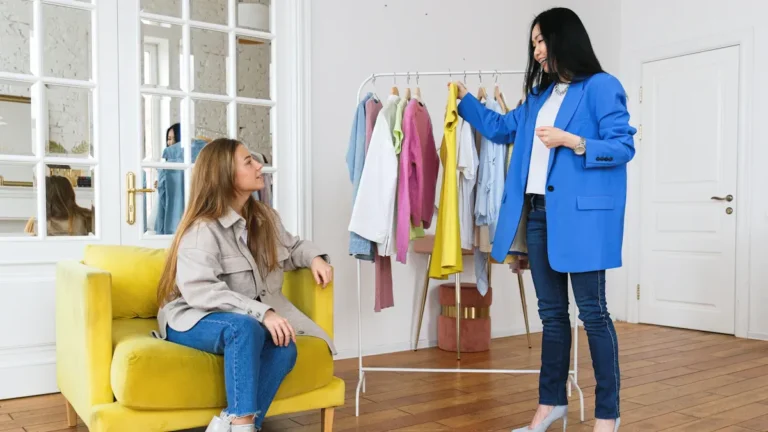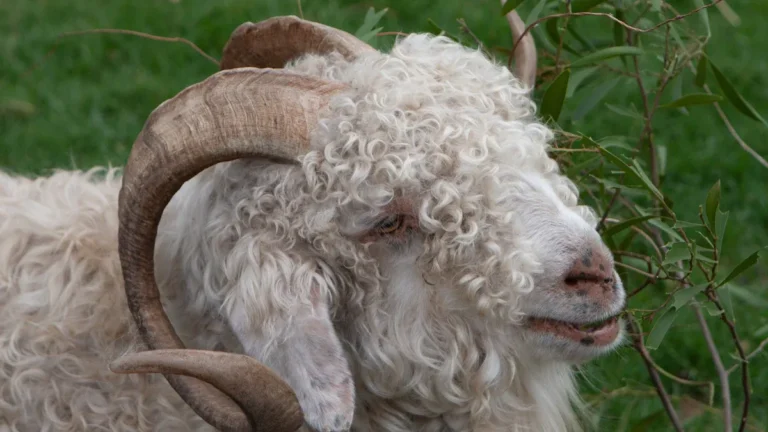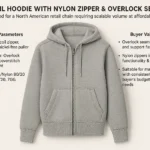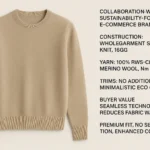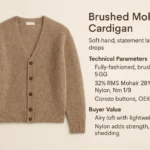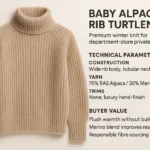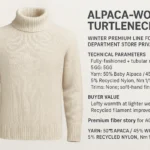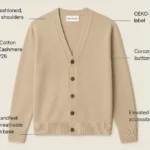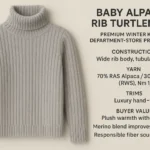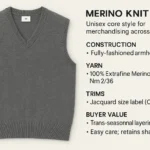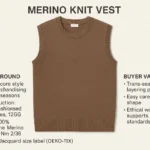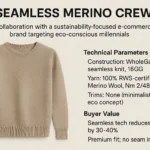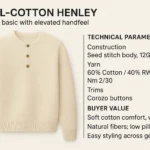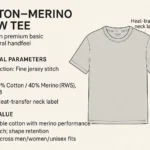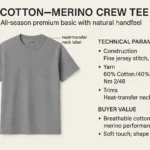
You can find good OEM factories by looking online, talking to people, and checking them carefully. Many companies buy wholesale cardigan sweaters straight from the makers. This way, you can better control the price, quality, and when you get your order.
Benefit | Description |
|---|---|
Quality | You can check sweater quality and make sure it is good enough. |
Delivery | Good delivery helps you keep your stock full on time. |
Cost | Buying straight from the maker often costs less than using a middleman. |
Key Takeaways
Buying from manufacturers costs less. You can give lower prices to customers. This helps your business get bigger.
Always ask for samples first. Samples help you check the quality. You can see if the factory is right for you.
Find factories with good certifications. Certifications mean the factory cares about safety and quality.
Use online sites and trade shows to find suppliers. These tools help you look at choices and meet factory owners.
Talk clearly with your supplier. Write down all details. This stops mistakes and keeps things easy.
Why Buy Directly from a Manufacturer
Cost Savings
You spend less money when you buy from a manufacturer. Manufacturers get materials for less money from suppliers. This helps you pay less for each sweater than if you buy from a distributor. You can use the extra money to help your business grow. You can also give your customers better prices. Many business owners pick wholesale cardigan sweaters to save money and watch their spending.
Custom Designs and OEM/ODM Services
You can get custom designs if you work with a manufacturer. You pick the yarn, color, and style you want. You also choose the sizes and any special features. Most factories offer OEM and ODM services. You can make your own brand or put your logo on sweaters. The table below shows the usual minimum order amounts for different types of orders:
Order Type | Minimum Quantity | Notes |
|---|---|---|
Sample Production | 1 | Single-piece sample production available. |
Small Orders | Varies | Fabric procurement occurs after confirmation due to higher costs. |
Large Orders | Customizable | Follows customer requirements for sourcing and production. |
You need to order at least 200 pieces for logo or graphic design.
You need to order at least 200 pieces for logo position.
Quality and Reliability
You can control quality better when you buy from a manufacturer. Good factories check sweaters many times to meet your standards. They look at raw materials, check patterns, and test for shrinkage and color. The table below lists common ways to check quality:
Quality Assurance Measure | Description |
|---|---|
Stitching and Seams | Check for even stitching, secure seams, and proper alignment. |
Fabric Quality | The fabric should feel consistent, with no weak areas or noticeable flaws. |
Fit and Sizing | The garment should conform to the size chart, and the fit should be comfortable. |
Color Consistency | Colors should be uniform, with no fading or variations. |
Finishing Details | Inspect finishing details like hems, buttons, zippers, and labels for quality. |
Shrinkage Tests | Ensures that the fabric doesn’t shrink beyond acceptable limits after washing. |
Colorfastness Tests | Checks the resistance of the fabric color to washing, light, and perspiration. |
Tensile Strength Tests | Determines how much force a fabric can withstand before breaking. |
Seam Slippage Tests | Measures the seam’s strength under stress. |
Pilling Test | Evaluates the fabric’s tendency to form pills after regular use. |
Material Inspection | Inspect fabric and accessories before production starts. |
In-process Checks | Inspect garments during the production process to catch defects early. |
Sampling and Testing | Perform sample checks on garments for quality standards. |
Final Inspection | Conduct a thorough final inspection of the completed garments. |
Packaging Inspection | Ensure proper packaging, labeling, and documentation before shipment. |
How AZKnit supports startups and global fashion brands
AZKnit helps your business grow with flexible choices. You can start with small orders, sometimes only 50 pieces for new styles. The company makes samples fast, often in 3 to 5 days. AZKnit uses eco-friendly materials and packaging to help the planet. With over 20 years of experience, AZKnit works with more than 30 brands around the world. Every order gets strict testing and checks to meet high standards.
Sourcing Wholesale Cardigan Sweaters
Getting the right supplier helps your business grow. You need to know where to search for good manufacturers. You can use online sites, go to trade shows, and make factory connections. These steps help you find sweaters that are good and arrive on time.
Online Platforms and Directories
Start by looking at online sites and directories. Many websites show lists of sweater suppliers and makers. You can see many styles, prices, and ways to customize. Some sites let you buy a lot or just a few. You can check prices and moqs before you order.
The Apparel Factory is a trusted place for cardigan sweaters. You get lots of styles and good prices. You can order with no minimum amount. The Apparel Factory lets you add embroidery or screen printing. ApparelBus ships fast in the U.S. and gives free shipping if you spend over $250. You can pick printing, embroidery, or tear-away labels.
Platform | Features | Customization Options | Pricing |
|---|---|---|---|
ApparelBus | Many styles, competitive pricing, fast U.S. shipping | Printing, embroidery, labels | Free shipping over $250 |
The Apparel Factory | No minimum order, wide selection, great discounts | Embroidery, screen printing | Competitive prices |
ApparelBus has many cardigan styles and fabrics. You can make sweaters special for your brand.
The Apparel Factory lets you order with no moqs and gives good bulk prices.
Tip: Always read reviews and ratings before picking a supplier. Good online sites help you find makers who send sweaters on time.
Trade Shows and Networking
You can meet top sweater makers at trade shows. Trade shows let you see samples and ask questions. You can compare products and talk with suppliers. You learn about new knitwear trends. You can talk about direct orders and buying in bulk face-to-face.
Here are some big trade shows for cardigan sweaters:
MAGIC Las Vegas: You see lots of clothes and textiles. You meet suppliers from many places.
Pitti Immagine Uomo: This show in Florence brings buyers and sellers together. You find high-quality knitwear.
Premiere Vision: This Paris event shows materials, accessories, and new designs.
Texworld USA: In New York City, you find fabrics and trims from many countries.
Note: Trade shows help you find makers who fit your needs. You can check sweater quality and talk about moqs in person.
Referrals and Factory Networks
You can ask other business owners for referrals. Referrals help you find makers with good records. You learn which suppliers send orders on time and give good sweaters. You also hear honest thoughts about prices and service.
Building a strong factory network helps you solve sourcing problems. Good factory networks make sure you get sweaters on time and with good quality. You can work with more than one supplier to avoid delays. You also get better prices when you buy a lot.
Ask trusted people in fashion for referrals.
Join online groups to talk about sweater suppliers.
Build relationships with makers who offer flexible moqs and ways to customize.
Tip: Good factory networks help you fix problems fast. You get better help and quick answers when you work with trusted suppliers.
Evaluating Sweater Factories

Certifications and Compliance
You need to check certifications when picking a sweater factory. Certifications show the factory cares about safety and quality. They also show the factory cares about the environment. These certificates help you trust the sweaters are made well. Look for these important certifications:
ISO 9001 (Quality Management)
GOTS (Global Organic Textile Standard)
Fair Trade Certification
OEKO-TEX Standard 100
SA8000 (Social Accountability)
Textile certifications give you confidence in the factory. They prove the factory follows strict rules for safety and quality. If a factory has these certificates, they want to do business the right way. This can help you sell in new places and get more customers.
Tip: Always ask for copies of certifications before you order a lot. This step helps you avoid problems with rules and quality later.
Requesting Samples
You should always ask for samples before picking a sweater supplier. Samples let you see the quality and feel the fabric. You can check the stitching, color, and fit. If you want custom designs, ask for samples with your logo or special features. This step helps you make sure the factory can do what you want.
You can compare samples from different sweater suppliers. Look for even seams, strong fabric, and good finishing. If a sample is not good enough, keep looking for better factories.
Note: Samples help you test moqs and production skills. You can ask for one piece or a small batch to see how the factory handles your order.
Client Feedback
You need to read client feedback before working with a factory. Feedback from other buyers tells you if the factory is reliable. You can find reviews online or ask for references. Good feedback means the supplier sends sweaters on time and meets quality standards.
Make a list of questions for past clients. Ask about delivery times, communication, and how the factory fixed problems. Honest feedback helps you avoid mistakes and find factories that care about your business.
Flat-bed knitting machines and yarn inventory
Flat-bed knitting machines are important for making sweaters. These machines use automation to make sweaters fast and with good patterns. You get better quality because the machines control speed and design. If the factory has many machines, they can make large orders and keep lead times short.
Yarn inventory is important too. A factory with enough yarn can keep making sweaters without delays. If the yarn runs out, production stops and you wait longer for your order. You should ask about the factory’s machine count and yarn stock before you order a lot.
Tip: High-efficiency machines and good yarn inventory help you get sweaters faster and with better quality.
How production flow works from sampling to shipment
You need to know how production works when you order sweaters in bulk. Each step affects quality and delivery time. Here are the main steps:
Design, Tech Specs, and Sample Approval: You send your design and specs. The factory makes a sample for you to approve.
Set a Production Timeline: You and the factory agree on lead times based on materials and order size.
Quality Control Measures: The factory sets up checks to prevent mistakes in knitting and finishing.
Yarn Preparation & Selection: The factory prepares and tests yarn for color and strength.
Knitting: Machines knit the panels with your chosen patterns.
Panel Assembly & Linking: Workers join the panels and add structure.
Washing, Blocking, & Pre-Shrinking: The sweaters go through finishing to keep their shape.
Quality Control & Inspection: The factory checks each sweater before packing.
You may also see these extra steps:
Tech Pack Receiving: The factory gets your order details.
CAD & Pattern Making: The factory uses computers to make accurate patterns.
Callout: You should ask for updates at each stage. This helps you track quality and solve problems early.
Quality control checkpoints for large orders
Factories use many checkpoints to keep sweater quality high. You should know what they check before you order a lot. Here is a table of standard checkpoints:
Checkpoint | Description |
|---|---|
Appearance | Evaluation of the garment’s visual appeal, color, and fabric consistency. |
Conformity of workmanship | Assessment of production against approved pre-production samples. |
Construction | Examination of stitching strength and durability for normal wear. |
Measurements | Verification of fitting accuracy across different sizes. |
Finishing | Determination of whether garments are ready for sale or require further work. |
Packing and labeling | Compliance check with buyer’s packing and labeling requirements. |
You should ask the factory about their quality control process. Make sure they check every sweater for defects. You can ask for reports or photos of inspections. This step helps you get sweaters that match your standards.
Tip: Strong quality control means fewer returns and happier customers. Always check moqs and production capacity before you choose a factory for bulk orders.
Negotiating and Managing Orders
Pricing and MOQs
You can get better prices if you know what you need. Factories may offer flexible choices if you ask questions. Sometimes, you can join with other buyers to meet moqs. Using standard materials can help you save money. Custom designs may cost more and need higher moqs. Always agree on payment and delivery dates. The table below shows ways to negotiate:
Strategy | Explanation |
|---|---|
Assessing Needs | Know your requirements and the factory’s capabilities. |
Asking Specific Questions | Ask about moqs, sample costs, and bulk production costs. |
Bundling Orders | Work with others to meet moqs and lower costs. |
Flexible Timelines | Allow longer timelines for smaller orders. |
Accepting Stock Materials | Use standard materials to reduce costs and moqs. |
Understanding Production Costs | Realize complex designs mean higher moqs. |
Clear Pricing and Payment Terms | Set fair prices and payment schedules. |
Setting Realistic Delivery Timelines | Agree on deadlines that fit the order. |
Quality Control Measures | Discuss quality assurance and penalties for poor quality. |
Contingency Planning | Prepare for problems with a solid plan. |
Lead Times and Payment Terms
Sweater production takes 8 to 24 weeks. The time depends on order size and materials. You pay a deposit before work starts. Most factories want 30% to 50% up front. You can pay by Letter of Credit, Advance T/T, or Net Terms. These choices help you manage your money and keep it safe. Always check payment rules before you order.
Communication Tips
Clear communication helps you get good sweaters. Write down all details and choices in one place. This stops mistakes with your sweater factory. Tell the factory what you expect after production. Learn about the supplier’s culture to build trust. Good talking helps you fix problems and get better sweaters.
Tip: Talking clearly means better sweaters and fewer problems.
Shipping terms: EXW, FOB, DDP
Shipping terms change your costs and jobs. The table below explains the main choices for bulk orders:
Shipping Term | Seller’s Responsibility | Buyer’s Responsibility |
|---|---|---|
EXW | Goods available at seller’s premises | All costs and risks from seller’s premises onward |
FOB | Goods transported to agreed port | Import formalities and costs after arrival |
DDP | All shipment aspects, duties, and taxes | Mainly receiving goods |
Pick the shipping term that works best for you. DDP means you do less work. EXW means you do most steps. FOB is a middle choice for buyers who want some control.
Key Quality Factors Before Bulk Ordering
Yarn type, yarn count, and gauge selection
You must pick the right yarn type, yarn count, and gauge. These choices change how your sweater feels and looks. They also affect how long it lasts. Most factories use medium, bulky, or super bulky yarns for wholesale cardigan sweaters. The table below shows yarn weights, needle sizes, and gauges:
Yarn Weight | Recommended Needle Size | Common Gauge (Knitting Stockinette) |
|---|---|---|
Medium (Worsted/Aran) | US 7-9 (4.5mm-5.5mm) | 16-20 stitches |
Bulky | US 9-11 (5.5mm-8mm) | 12-15 stitches |
Super Bulky | US 11-17 (8mm-12.75mm) | 7-11 stitches |
Jumbo | US 17 and larger (15mm and larger) | 6 stitches and fewer |

Talk to top sweater makers about yarn and gauge. The right choice helps you get the look and quality you want.
Stitch type and knitting construction
Stitch type and knitting construction matter for how your sweater wears. Factories use different stitches for strength, stretch, and style. The table below explains common stitch types and their effects:
Stitch Type | Application in Knitwear | Impact on Durability and Appearance |
|---|---|---|
Overlock Stitches | Used for seaming and edge finishing in stretchy fabrics. | Provides elasticity to prevent seams from popping, enhancing durability. |
Coverstitches | Ideal for hemming and areas requiring high stretch. | Maintains the garment’s appearance while allowing for movement, crucial for activewear. |
Lockstitch | Generally unsuitable for stretchy knits; used in woven fabrics. | Offers strength but lacks elasticity, leading to potential seam breakage in stretchy garments. |
Zigzag Stitches | Can be used decoratively or for areas needing flexibility. | Adds visual interest while allowing for some stretch, impacting the overall aesthetic. |
Flatlock Seams | Preferred for close-fitting garments to reduce bulk. | Enhances comfort and appearance by minimizing seam visibility, important for activewear aesthetics. |
Ask your factory to use the stitch that fits your needs.
Dimensional stability, shrinkage, and panel tension
You want sweaters to keep their shape after washing. Dimensional stability means sweaters do not shrink or stretch too much. Industry rules allow up to 7% shrinkage (AATCC) or 5% (ISO). Some factories use stricter limits, like 4%, for better quality. Ask about shrinkage tests and panel tension checks before you order.
Tip: Always ask for shrinkage and stability test results. This helps you avoid problems with your bulk order.
Pre-production samples and approval process
You must approve pre-production samples before mass production starts. This step lets you check design, fit, and quality. Here is how the process works:
The factory makes a sample using your design and specs.
You give details like CAD files, drawings, and material samples.
You may see several sample versions before you approve one.
The factory runs a small batch to find problems before full production.
Check each sample carefully. This process helps you get the custom sweater you want and lowers mistakes in your wholesale order.
Private Label & OEM Customization Options

If you work with top sweater makers, your brand can stand out. Private label and OEM services let you add special details to sweaters. These choices help you build a strong brand. You can offer something different in the wholesale market.
Logo embroidery, jacquard branding, and woven labels
You have many ways to show your brand on sweaters. Factories can add logo embroidery, jacquard branding, or woven labels. These features make your sweaters look professional. They help customers remember your brand.
Feature | Description |
|---|---|
Customization | You can design woven labels with your logo. This helps your brand look unique and strong. |
Durability | Woven labels last a long time. They keep their details after many washes. |
Craftsmanship | Factories use jacquard looms for labels. These labels can have up to twelve colors. |
Material | Labels use strong polyester. They stay bright and do not fade. |
Tip: Adding your logo or label to sweaters helps your brand stand out in stores and online.
Custom packaging, barcode, and hangtag service
Custom packaging and hangtags give sweaters a finished look. You can pick thick paper hangtags, woven labels, or embossed neck tags. These items show your logo, product details, and care instructions. Barcodes help with tracking and sales.
Product Type | Supplier | Rating | MOQ | Price Range |
|---|---|---|---|---|
Luxury Thick Paper Custom Hangtag | Dongguan Zhongxin | 4.9 | 100 | $0.02-$0.12 |
Printed Woven Label | Jcbasic Garment Accessories | 4.4 | 100 | $0.01-$0.20 |
Factory Price Custom Clothing Label | Jiaxing Wuyue | 4.9 | 500 | $0.08-$0.15 |
Custom Sustainable Embossed Neck Tags | Guangdong Yuanchuang | 4.8 | 100 | $0.15-$0.30 |

Hangtags tell customers about the sweater’s size, care, and story.
Custom packaging makes your product look fancy and ready for stores.
Color matching, yarn dyeing, and size range customization
You can match any color you want for your sweater. Factories offer yarn dyeing to get the exact shade you need. You can also pick the yarn type and size range for your order. This helps you meet your customers’ needs and follow new trends.
Description | |
|---|---|
Designs | You can create fully custom sweater designs. |
Materials | Choose from many premium yarns. |
Branding Elements | Add logos, tags, and labels. |
Yarn Type | Pick the yarn type and color. |
Patterns | Select patterns and styles. |
Cut and Sew Services | Get unique shapes and fits. |
Note: Sampling before production lets you check the color, fit, and feel of your custom sweater.
Case Study: How a European Boutique Scaled with Bulk Orders
From sampling to final shipment
You own a boutique in Europe. You want to sell new sweaters. First, you look for a good factory. You ask the factory to send you samples. You check if the sample sweater fits well and feels nice. If you like it, you tell the factory to make more. The factory tells you when each step will happen. You get updates as they work on your order. When the sweaters are ready, the factory packs them up. You watch the shipment as it travels to you. Your sweaters arrive on time.
Tip: Ask for updates at every step. This helps you know what is happening and stops delays.
Custom cotton
You want your sweaters to be special. You pick custom cotton yarn for softness and strength. The factory helps you choose the best yarn and color. You test the sweater to see if it is comfy and does not shrink. The factory dyes the yarn to match your brand’s colors. You check the final look before they make all the sweaters. Your customers like the soft feel and special look.
Custom cotton yarn makes your sweaters feel fancy.
You can match the colors to your brand for a strong look.
Lessons learned for MOQ, pricing, and communication
You learn a lot from your big order. You find out that setting a clear MOQ helps you plan how many sweaters to buy. You talk about prices with the factory based on how many you order and what yarn you use. You keep talking with the factory so everyone knows what to do. You write down what you want and expect. If there is a problem, you ask questions and share your thoughts to fix it fast.
Lesson | How It Helps Your Business |
|---|---|
Clear MOQ | Stops you from having too many or too few sweaters |
Smart Pricing | Helps you save money and earn more |
Good Communication | Lowers mistakes and builds trust |
Note: You can grow your boutique by working closely with your factory and making sure your sweaters are high quality.
Overcoming Sourcing Challenges
Language Barriers
When you work with a sweater factory in another country, you may face language barriers. Misunderstandings can happen if you and the supplier do not speak the same language well. You can solve this by using clear and simple words in your emails. Try to avoid slang or complex phrases. Many factories have staff who speak English, but you should always double-check important details. If you feel unsure, you can use translation tools or hire a local translator for big orders.
Tip: Ask your supplier to confirm your order details in writing. This helps prevent mistakes in your sourcing process.
Logistics and Shipping
Shipping sweaters from a factory to your warehouse can be tricky. You need to plan for customs, shipping times, and possible delays. You should ask your supplier about their shipping partners and how they handle logistics. Some suppliers offer tracking numbers so you can follow your order. Make sure you know who pays for shipping and who handles customs. This keeps your wholesale sweater order on track.
Check shipping terms before you agree to a deal.
Track your order to avoid surprises.
Quality Control
You want every sweater to meet your standards. Quality control is a key part of sourcing. You should ask the factory about their inspection steps. Request photos or videos of finished sweaters before they ship. You can also hire a third-party inspector to check the sweaters at the factory. This step helps you catch problems early and keeps your customers happy.
Note: Good quality control saves you money and builds trust with your buyers.
Using Sourcing Agents
A sourcing agent can help you find the right sweater supplier. Agents know the local market and speak the language. They can visit the factory for you and check the quality of the sweaters. You pay a fee, but you save time and avoid many problems. If you are new to sourcing, an agent can make the process easier and safer.
Benefit of Sourcing Agent | How It Helps You |
|---|---|
Local Knowledge | Finds the best factories faster |
Language Skills | Avoids misunderstandings |
Quality Checks | Inspects sweaters before shipping |
Saves Time | Handles sourcing steps for you |
You can find reliable OEM factories if you follow easy steps. First, look online for good suppliers. Go to trade shows to meet factory owners. Ask people you trust for referrals. Always ask for samples from the factory. Check if the factory has the right certifications. Buying straight from manufacturers saves you money. You also get more control over quality. Talk clearly with your supplier to avoid mistakes.
Tip: Start with a small order. This helps you check quality and service before you grow your business.
FAQ
What is the typical minimum order quantity (MOQ) for wholesale cardigan sweaters?
Most factories want you to order 100 to 300 sweaters. Some let you order fewer if you want a new style or just a sample.
Order Type | MOQ Range |
|---|---|
Sample | 1–5 |
Bulk | 100–300 |
How do you check the quality before placing a large order?
First, you ask for a sample sweater. You look at the stitching, color, and how it fits. You can also ask for pictures or videos of finished sweaters.
Tip: Always check and approve a sample before you order a lot.
Can you customize labels and packaging for your brand?
You can make your own labels, hangtags, and boxes. Factories let you pick things like woven labels, printed tags, or special boxes.
Woven labels
Hangtags
Custom boxes
What payment methods do most OEM factories accept?
You can pay by bank transfer, Letter of Credit, or PayPal. Some factories let you use a credit card for small orders.
Payment Method | Common Use |
|---|---|
T/T | Bulk orders |
Letter of Credit | Large shipments |
PayPal | Samples |






